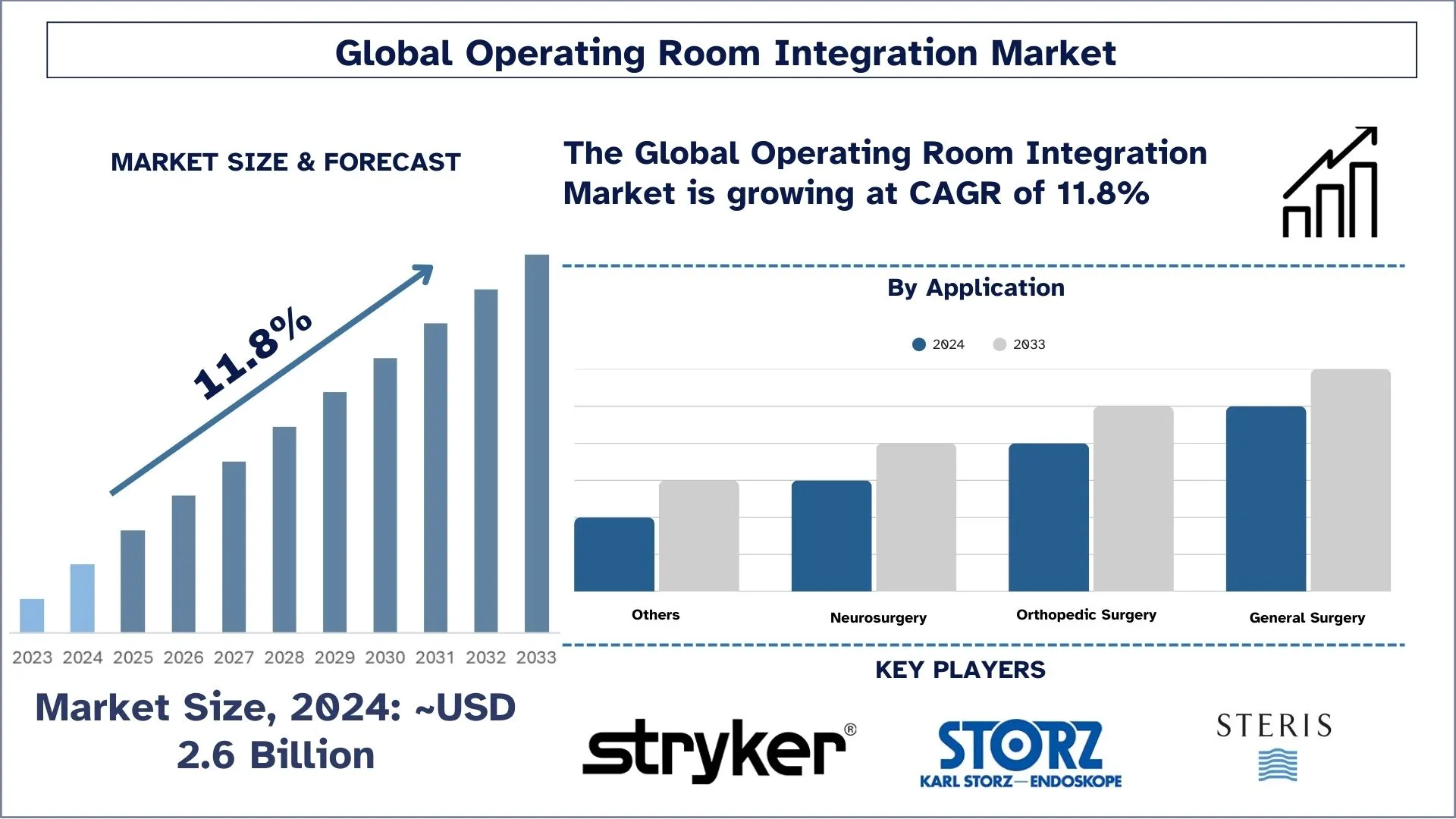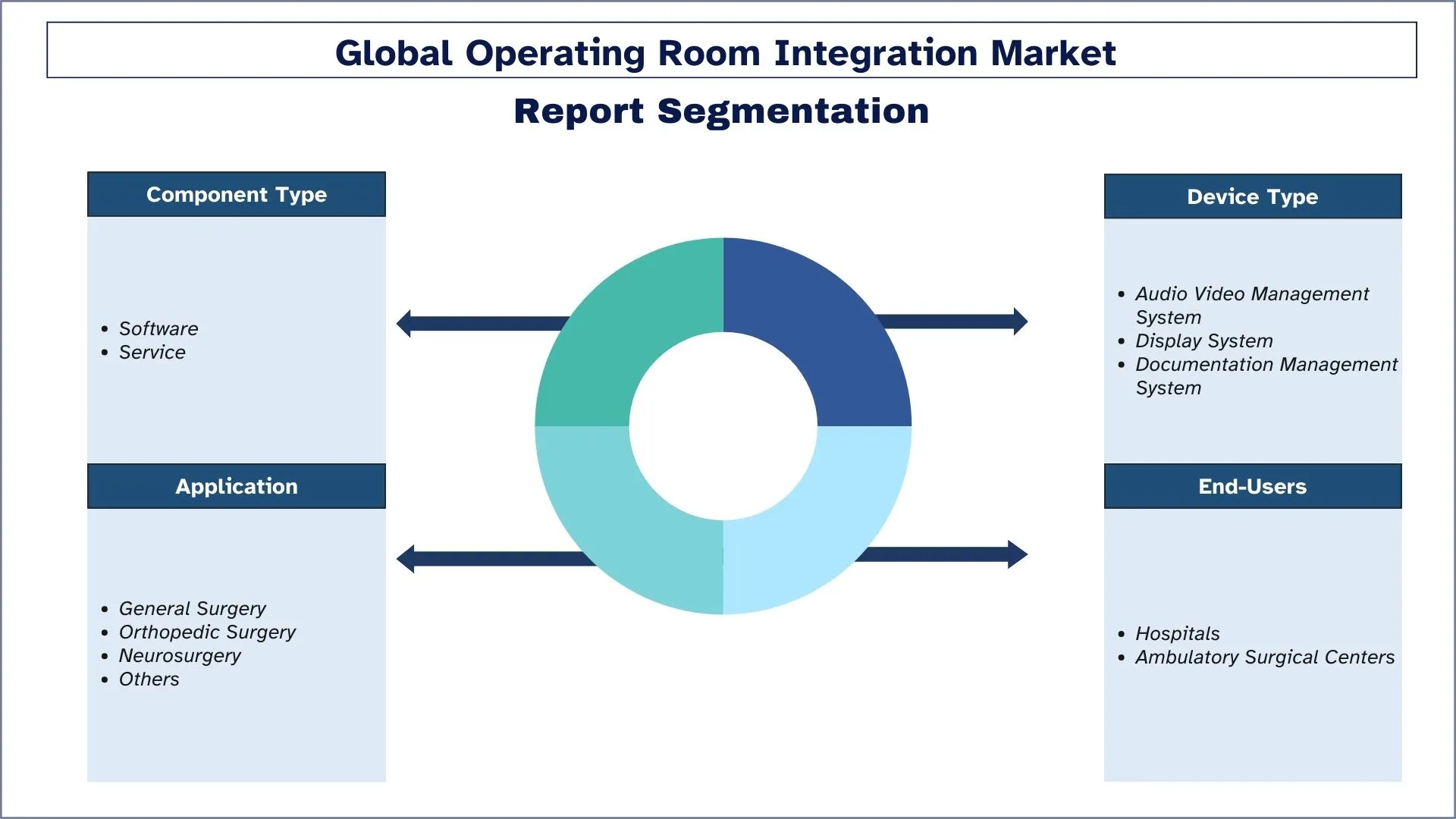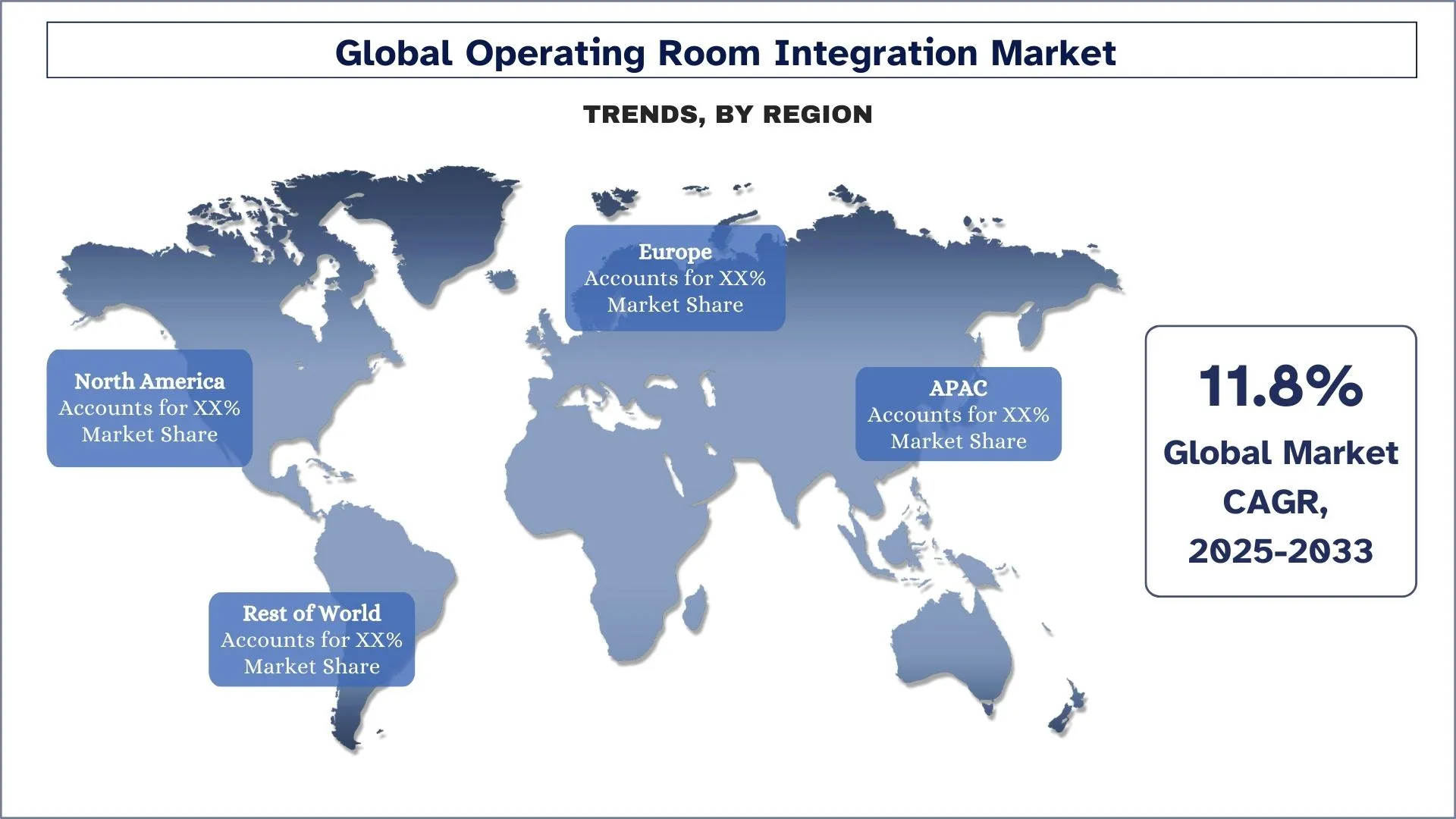- Inicio
- Acerca de nosotros
- Industria
- Servicios
- Leyendo
- Contáctenos
Mercado de Integración de Quirófanos: Análisis Actual y Pronóstico (2025-2033)
Énfasis en el Tipo de Componente (Software y Servicio); Tipo de Dispositivo (Sistema de Gestión de Audio y Video, Sistema de Visualización y Sistema de Documentación); Aplicación (Cirugía General, Cirugía Ortopédica, Neurocirugía, Otros); Usuarios Finales (Hospitales, Centros Quirúrgicos Ambulatorios); Región/País

Tamaño y pronóstico del mercado de integración de quirófanos
El mercado de integración de quirófanos se valoró en aproximadamente USD 2.6 mil millones en 2024 y se espera que crezca a una TCAC sustancial de alrededor del 11.8% durante el período de pronóstico (2025-2033), debido a la creciente demanda de flujos de trabajo quirúrgicos eficientes y sin errores.
Análisis del mercado de integración de quirófanos
El quirófano integrado está diseñado para reducir la complejidad de los entornos más complejos en hospitales, clínicas privadas o instituciones médicas. El último quirófano integrado está equipado con una variedad de equipos quirúrgicos, así como sistemas de gestión de equipos, impresoras médicas, inyectores, microscopios quirúrgicos, luces quirúrgicas, cámaras, pantallas grandes y equipos de gestión del aire. El sistema de integración de quirófanos no solo integra dispositivos, sino que también conecta funcionalmente entornos de quirófanos como sistemas de información de pacientes, audio, video, luces de quirófanos, mesas de quirófanos y automatización de edificios. Cuando todas estas tecnologías están integradas, los diversos dispositivos serán controlados por un solo operador que puede ser un médico o enfermero.
Tendencias del mercado de integración de quirófanos
Esta sección analiza las principales tendencias del mercado que influyen en los diversos segmentos del mercado de integración de quirófanos, según lo identificado por nuestros expertos en investigación.
La creciente adopción de la inteligencia artificial (IA) y la robótica
La expansión operativa en las salas de operaciones muestra un aumento significativo hacia la incorporación de inteligencia artificial y sistemas robóticos para mejorar la precisión quirúrgica junto con la eficacia operativa. El mercado de ORI se beneficia de los algoritmos de IA que respaldan las decisiones quirúrgicas y la planificación preoperatoria, así como de la guía intraoperatoria y los sistemas robóticos que ejecutan procedimientos mínimamente invasivos con un control mejorado. La IA con sistemas robóticos trabaja en conjunto en la cirugía para transformar el flujo de trabajo, mejorando así el éxito del paciente al tiempo que optimiza la eficiencia del quirófano.
Segmentación de la industria del mercado de integración de quirófanos
Esta sección proporciona un análisis de las tendencias clave en cada segmento del informe del mercado global de integración de quirófanos, junto con pronósticos a nivel global, regional y de país para 2025-2033.
Se espera que el segmento de cirugía general sea testigo de una TCAC más alta que el mercado de integración de quirófanos.
Según la aplicación, el mercado se segmenta en cirugía general, cirugía ortopédica, neurocirugía y otros. Entre las aplicaciones, la categoría de cirugía general representó una parte importante del mercado. La cirugía general incluye cirugía en varios órganos y afecciones, como el tracto digestivo (esófago y órganos relacionados), el abdomen y su contenido, los senos, la piel y los tejidos blandos, y el sistema endocrino. Por lo tanto, el aumento en los casos de cáncer de mama, trastornos endocrinos, cáncer de hígado, etc., contribuye a la gran cantidad de procedimientos quirúrgicos generales, lo que a su vez está impulsando el crecimiento del mercado.
El segmento de hospitales tiene la mayor cuota de mercado.
Según los usuarios finales, el mercado se bifurca en hospitales y centros quirúrgicos ambulatorios. Entre los usuarios finales, la categoría de hospitales representó una parte importante del mercado. Debido a la gran cantidad de pacientes expuestos a enfermedades crónicas, los IOR deben reducir la carga y la complejidad para los médicos y aumentar el número de hospitales establecidos en los países en desarrollo para gestionar eficazmente los flujos de trabajo quirúrgicos. Además, la innovación continua en los dispositivos médicos ha contribuido al aumento de la adopción de IOR en los próximos años.

América del Norte tiene una participación importante del mercado en 2024.
Los países de América del Norte dominan el mercado de integración de quirófanos (ORI) porque tienen instalaciones de atención médica avanzadas, junto con numerosos procedimientos quirúrgicos, junto con la rápida aceptación de los procedimientos que utilizan técnicas quirúrgicas mínimamente invasivas. Los sistemas OR integrados han ganado una adopción generalizada porque la región se centró en mejorar los resultados quirúrgicos al tiempo que acortaba los tiempos de los procedimientos a través de la optimización de los procesos. Las soluciones ORI experimentan el crecimiento del mercado debido a importantes actores de la industria y sólidas actividades de I+D, e inversiones fundamentales en la modernización de hospitales. El número creciente de personas mayores, junto con el aumento de la incidencia de enfermedades crónicas, crea una demanda sostenida de instalaciones quirúrgicas eficientes basadas en la tecnología en toda la región de Asia y el Pacífico.
Estados Unidos domina el mercado norteamericano de integración de quirófanos
El mercado de integración de quirófanos en los EE. UU. demuestra un crecimiento sólido porque las instalaciones de atención médica adoptan tecnologías quirúrgicas superiores a un ritmo mayor al tiempo que gestionan un mayor número de casos de pacientes crónicos. Las soluciones quirúrgicas que se integran han ganado una demanda sustancial porque una gran parte de la población ahora enfrenta afecciones crónicas. Actualmente, el sistema de atención médica de los EE. UU. se centra en las mejoras quirúrgicas y la reducción de costos a través de soluciones OR integradas, que optimizan los procedimientos del flujo de trabajo al tiempo que mejoran la precisión quirúrgica. El mercado de Estados Unidos se expande debido a sus instalaciones de atención médica bien establecidas y su enfoque activo impulsado por la investigación.

Panorama competitivo de la industria del mercado de integración de quirófanos
El mercado de integración de quirófanos es competitivo, con varios actores globales e internacionales. Los actores clave están adoptando diferentes estrategias de crecimiento para mejorar su presencia en el mercado, como asociaciones, acuerdos, colaboraciones, lanzamientos de nuevos productos, expansiones geográficas y fusiones y adquisiciones.
Principales empresas del mercado de integración de quirófanos
Algunos de los principales actores que operan en el mercado son Stryker Corporation, KARL STORZ GmbH & Co. KG, STERIS plc, Skytron LLC, Getinge AB, Merivaara Oy, Canon Inc., BrainLab AG, Doricon Medical System y Olympus Corporation.
Desarrollos recientes en el mercado de integración de quirófanos
- En febrero de 2023, KARL STORZ colaboró con Asensu Surgical (EE. UU.). A través de esta colaboración, la compañía desarrolló equipos de última generación y apuntó a vender la Unidad Quirúrgica Inteligente (ISU) de Asensus como un dispositivo independiente.
- En febrero de 2022, Stryker adquirió Vocera Communications (EE. UU.). Esta adquisición ofrece a la división médica de Stryker una cartera innovadora que impulsa los servicios de atención médica digital avanzada de la compañía y promueve el enfoque de Stryker en la prevención de eventos adversos en todo el continuo de la atención.
Cobertura del informe del mercado de integración de quirófanos
Detalles | |
Año base | 2024 |
Período de pronóstico | 2025-2033 |
Impulso de crecimiento | Acelerar a una TCAC del 11.8% |
Tamaño del mercado en 2024 | USD 2.6 mil millones |
Análisis regional | APAC, Europa, Asia-Pacífico, Resto del mundo |
Principal región contribuyente | Se espera que América del Norte crezca a la TCAC más alta durante el período previsto. |
Países clave cubiertos | EE. UU., Canadá, Alemania, Francia, Reino Unido, España, Italia, China, Japón e India |
Stryker Corporation, KARL STORZ GmbH & Co. KG, STERIS plc, Skytron LLC, Getinge AB, Merivaara Oy, Canon Inc., BrainLab AG, Doricon Medical System, Olympus Corporation. | |
Alcance del informe | Tendencias del mercado, impulsores y restricciones; Estimación y previsión de ingresos; Análisis de segmentación; Análisis de la oferta y la demanda; Panorama competitivo; Perfiles de empresa |
Segmentos cubiertos | Por tipo de componente, por tipo de dispositivo, por aplicación, por usuarios finales, por región/país |
Razones para comprar el informe del mercado de integración de quirófanos:
- El estudio incluye el tamaño del mercado y el análisis de pronóstico validados por expertos clave autenticados de la industria.
- El informe presenta una revisión rápida del rendimiento general de la industria de un vistazo.
- El informe cubre un análisis en profundidad de los pares prominentes de la industria con un enfoque principal en las finanzas comerciales clave, las carteras de productos, las estrategias de expansión y los desarrollos recientes.
- Examen detallado de los impulsores, las restricciones, las tendencias clave y las oportunidades que prevalecen en la industria.
- El estudio cubre de manera integral el mercado en diferentes segmentos.
- Análisis profundo a nivel regional de la industria.
Opciones de personalización:
El mercado global de integración de quirófanos se puede personalizar aún más según los requisitos o cualquier otro segmento de mercado. Además de esto, UnivDatos entiende que puede tener sus propias necesidades comerciales; por lo tanto, no dude en contactarnos para obtener un informe que se adapte completamente a sus necesidades.
Tabla de contenido
Metodología de Investigación para el Análisis del Mercado de Integración de Quirófanos (2023-2033)
Analizamos el mercado histórico, estimamos el mercado actual y pronosticamos el mercado futuro del Mercado global de Integración de Quirófanos para evaluar su aplicación en las principales regiones del mundo. Realizamos una exhaustiva investigación secundaria para recopilar datos históricos del mercado y estimar el tamaño actual del mercado. Para validar estos conocimientos, revisamos cuidadosamente numerosos hallazgos y suposiciones. Además, realizamos entrevistas primarias en profundidad con expertos de la industria en toda la cadena de valor del Mercado de Integración de Quirófanos. Después de validar las cifras del mercado a través de estas entrevistas, utilizamos enfoques de arriba hacia abajo y de abajo hacia arriba para pronosticar el tamaño general del mercado. Luego, empleamos métodos de desglose del mercado y triangulación de datos para estimar y analizar el tamaño del mercado de los segmentos y subsegmentos de la industria.
Ingeniería de Mercado
Empleamos técnicas de triangulación de datos para finalizar la estimación general del mercado y derivar números estadísticos precisos para cada segmento y subsegmento del Mercado global de Integración de Quirófanos. Dividimos los datos en varios segmentos y subsegmentos analizando varios parámetros y tendencias, incluido el tipo de componente, el tipo de dispositivo, la aplicación, los usuarios finales y las regiones dentro del Mercado global de Integración de Quirófanos.
El objetivo principal del Estudio del Mercado Global de Integración de Quirófanos
El estudio identifica las tendencias actuales y futuras en el Mercado global de Integración de Quirófanos, proporcionando información estratégica para los inversores. Destaca el atractivo del mercado regional, lo que permite a los participantes de la industria aprovechar los mercados sin explotar y obtener una ventaja de ser los primeros en actuar. Otros objetivos cuantitativos de los estudios incluyen:
- Análisis del Tamaño del Mercado: Evaluar el tamaño actual y previsto del mercado global de Integración de Quirófanos y sus segmentos en términos de valor (USD).
- Segmentación del Mercado de Integración de Quirófanos: El estudio segmenta el mercado por tipo de componente, tipo de dispositivo, aplicación, usuarios finales y región.
- Marco Regulatorio y Análisis de la Cadena de Valor: Examinar el marco regulatorio, la cadena de valor, el comportamiento del cliente y el panorama competitivo de la industria del Mercado de Integración de Quirófanos.
- Análisis Regional: Realizar un análisis regional detallado para áreas clave como Asia Pacífico, Europa, América del Norte y el resto del mundo.
- Perfiles de Empresas y Estrategias de Crecimiento: Perfiles de empresas del Mercado de Integración de Quirófanos y las estrategias de crecimiento adoptadas por los líderes del mercado para sostener el mercado de rápido crecimiento.
Preguntas frecuentes Preguntas frecuentes
P1: ¿Cuál es el tamaño actual y el potencial de crecimiento del mercado de Integración de Quirófanos?
A partir de 2024, el mercado global de Integración de Quirófanos está valorado en aproximadamente USD 2.6 mil millones y se proyecta que crecerá a una CAGR del 11.8% hasta 2033.
P2: ¿Cuáles son los factores impulsores del crecimiento del mercado de Integración de Quirófanos?
Los proveedores de atención médica están bajo una presión cada vez mayor para mejorar los resultados quirúrgicos, reducir el tiempo del procedimiento y mejorar la seguridad del paciente. Los quirófanos integrados agilizan el acceso a datos críticos, imágenes y control de dispositivos en tiempo real, impulsando la demanda en los mercados desarrollados y emergentes.
P3: ¿Qué mercado tiene la mayor cuota del mercado de Integración de Quirófanos por tipo de componente?
El segmento de Software domina el mercado global de Integración de Quirófanos por el segmento de tipo de componente.
P4: ¿Cuáles son las principales tendencias en el mercado de Integración de Quirófanos?
El mercado está presenciando un cambio hacia los sistemas de quirófano mejorados con IA, lo que permite el análisis predictivo, la documentación automatizada y la guía quirúrgica en tiempo real. La integración con los HCE de los hospitales y las plataformas basadas en la nube también se está convirtiendo en un estándar, lo que respalda ecosistemas de quirófano más inteligentes y conectados.
P5: ¿Qué región dominará el mercado de Integración de Quirófanos?
La región de Norteamérica domina actualmente el mercado global de integración de quirófanos.
P6: ¿Cuáles son los mayores desafíos en el mercado de la Integración de Quirófanos?
A pesar de los beneficios de eficiencia a largo plazo, el costo inicial de la integración del quirófano, combinado con la complejidad técnica, los requisitos de capacitación del personal y la necesidad de modernizar los sistemas heredados, representa una barrera para la adopción generalizada, especialmente en entornos sensibles a los costos o con recursos limitados.
P7: ¿Quiénes son los principales actores en el mercado global de Integración de Quirófanos?
Las principales empresas que impulsan la innovación en el mercado de Integración de Quirófanos incluyen:
• Stryker Corporation
• KARL STORZ GmbH & Co. KG
• STERIS plc
• Skytron LLC
• Getinge AB
• Merivaara Oy
• Canon Inc.
• BrainLab AG
• Doricon Medical System
• Olympus Corporation
P8: ¿Qué papel juega la interoperabilidad en el éxito de las soluciones de integración de quirófanos?
La interoperabilidad es fundamental en el quirófano integrado (ORI) ya que garantiza una comunicación fluida entre los dispositivos quirúrgicos, los sistemas de imagenología, los sistemas de información hospitalaria (HIS) y los registros médicos electrónicos (EMR). Los sistemas integrados que admiten arquitecturas abiertas y plataformas independientes del proveedor reducen la fragmentación del flujo de trabajo, mejoran la eficiencia quirúrgica y permiten una mejor toma de decisiones basada en datos. La interoperabilidad también mejora la escalabilidad para los hospitales que actualizan o amplían sus sistemas.
P9: ¿Cómo pueden las empresas de dispositivos médicos o las empresas de tecnología entrar o expandirse estratégicamente en el espacio de Integración de Quirófanos?
Las empresas que buscan ingresar o escalar en el mercado de la ORI deben centrarse en soluciones interoperables, el cumplimiento de las regulaciones de atención médica (por ejemplo, HIPAA, FDA) y la formación de asociaciones estratégicas con hospitales, fabricantes de equipos originales quirúrgicos o integradores de tecnología de la salud. Enfatizar la ciberseguridad, la escalabilidad y la integración perfecta con los sistemas informáticos hospitalarios existentes (como los EMR y los PACS) también será fundamental. Apuntar a los mercados emergentes y ofrecer soluciones ORI modulares o basadas en la nube puede desbloquear aún más el potencial de crecimiento.
Relacionados Informes
Los clientes que compraron este artículo también compraron










